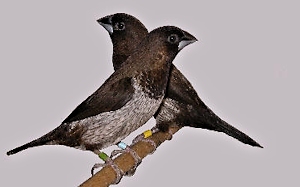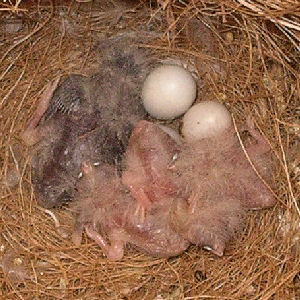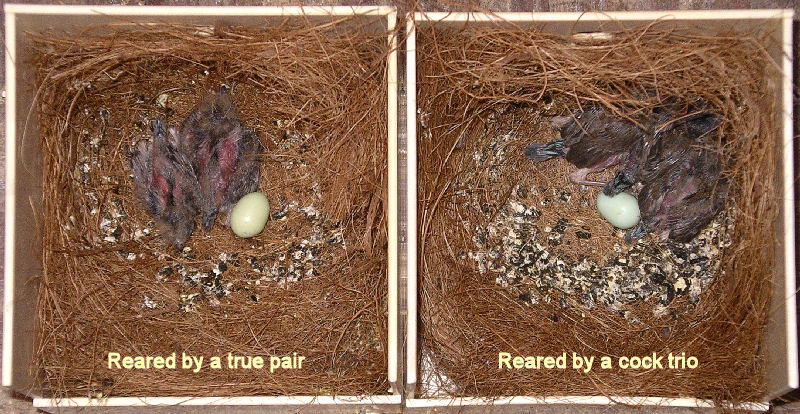Fostering makes sense initially
Due to numbers now being bred, fostering versus parent rearing is no longer an
easy decision. Especially as all birds are now captive-bred
For newcomers to waxbills though, fostering is a good way to start to build up a
breeding stud with nice, young birds. Then can learn successful parent rearing
knowing there is a viable UK population
In my first season, the only parent-rearing success was from a captive-reared
hen. In those days, wild-caught were still available
In only 3 months of fostering, there were numerous chicks from different pairs of
wild-caught Cordon-bleu parents. This continued through 2009 using F1's)
Fostering normally means that 50% of eggs laid will result in independent chicks
(but this includes all the infertile eggs from 2 'battery hens' - otherwise,
fertility is ~ 90%)
Fostering delivers, even though it isn't natural and doesn't feel quite right, it
is a great way to learn while building up a flock

Pair of good Bengalese fosters
Fosters vary
With good fosters, all fledglings lack any tufts of head down. From 'okay' fosters,
some fledglings have tufts of head down
From poor fosters (or old/ unfit parents), 1 or more chicks fledge incompletely
feathered or can't even fly
If initially results aren't good, try again with eggs from other another Blue-capped
pair. If it's another poor result, use such Bengalese to foster rear eggs from
good foster Bengalese
Why are some poor fosters of Blue-capped? A common theory is rejection is due to dark
skin colour (and down). I'm not convinced
Bengies' chicks are much, much noisier. It could be down to sound.
It doesn't matter
Get some good Bengalese fosters from Gouldian, Parrot finch or better still, other
waxbill breeders
Once you have a good strain, its very easy. Good fostering seems to be inherited
Only risk a couple of fertile eggs (make up the clutch of say 5 eggs with china eggs)
on an untried pair or trio of Society finches
Some will happily foster at 8 months
If Bengalese are young ie under a year old, they may fail the first time.
Don't give up on them
If Bengalese are about a year old and have had 2 Blue-capped nests and failed to rear,
then give up on the those Bengies
Cock trios every time for me
Can induce cock trios to go clucky in 4 days
1 china egg added to nest each morning for 4 consecutive days
Start making them go clucky as soon as know have a waxbill nest
No egg-laying cycles
No distracting extra eggs laid
This example involves Pin-tailed parrot-finch chicks but hopefully the example
is still sound)
The photo below shows two nests which hatched on the same day and had exactly the
same food/ regimen/ cage
The trio's chicks are bigger, better developed and
better feathered than the pair's chicks
The trio's chicks have already started moving around the nest
What goes in comes out. Much more droppings in the trio's 3 chick versus
the pair's 2 chick nest
Not just due to the nest having one more chick.
Trio's chicks crop's were invariably much fuller
One cock and two hens or all hen trios? The hens compete for the eggs so
fewer are consistently brooded so fewer hatch
So, cock trios every time
Bursting
Better if you can stop peeking at the chicks as they near full feather from days 13
or 14 onwards
Otherwise you might induce a 'burst' and the weakest/ youngest
could suffer
If you see fewer waxbills to the perch than when you last inspected prior to fledging,
try not to look in the nest
The smallest/ weakest will 'burst' and an extra day in the nest can be the
difference between surviving or not
Fledging time varies
Blue-capped Waxbills don't all necessarily fledge on the same day.
One might be early or 1 might be late (usually all within 2 days though.
This fits with the egg hatching times. 1 nest was 4 days)
Fledge at about days 18 - 20. It varies with different fosters, (average - 18.5 days)
The waxbill chicks return to the nest for the first few days during the day and
especially at night
Reduce chance of imprinting
Faced with a small, not fully feathered fledgling, I turn the heater up to 20°C (70°F)
for 2 day
Only one or two chicks fledge, so are more Society Finches than Cordon-bleus!!
If possible, transfer one or two older Blue-capped waxbills, which are steady in
small foster cages, for 3 or 4 weeks
It means at least youngsters see behaviour of, and socialise with, other Cordon-bleu
Finches
Weaning - minimise the stress
Waxbills may be weaned at 16 days. The sooner they mix with other Blue-capped
the better to learn to socialise
When weaned, don't transfer from a small foster cage to an aviary in one giant leap
Try an intermediate week or two in a small cage and work up to bigger things
If going to a flight cage transfer one or two Bengalese as well just for 2 or 3 days
The young waxbills will be more comfortable and the adventurous Bengalese will find the
seed and water soonest
Ensure seed and water dispensers are of the same type, colour and positioning as before
This helps the youngsters find them
Having said that, Blue-capped youngsters are pretty intelligent as fledlings
Useless information, the beak changes from black to 'pink' a month after fledging.
The first moult is at just under 3 months. They go through the moult without
any fuss
Bengalese (Society Finches) or Zebra Finches as Cordon-bleu Fosters
I tried unsuccessfully but some breeders advocate using Zebras to foster
Why bother when Bengalese are wonderfuly steady, predictable and controllable?
A 'trio' of Society finch cocks can be made clucky within 3 - 4 days but...
Some Bengalese wont feed Blue-capped waxbill chicks
The skin colour and/ or the heavy down may contribute
Big downside of Zebra Finches versus Society finches as fosters is are harder
to make 'clucky' when it suits you
So, you must have a pair breeding 'in sync' which means keeping more Zebra finch pairs
Upsides - photo shows dark and light skin coloured Zebra chicks in same nest
plus quite a lot of down AND ...
Zebras don't roost as early as Bengalese
In winter early
roosting Bengalese limit feeding time and extends 'night'

Zebra Finch chicks - 1 nest, same parents, different skin colour, down & varying sizes
Fostering makes sense initially
Due to numbers now being bred, fostering versus parent rearing is no longer an
easy decision. Especially as all birds are now captive-bred
For newcomers to waxbills though, fostering is a good way to start to build up a
breeding stud with nice, young birds. Then can learn successful parent rearing
knowing there is a viable UK population
In my first season, the only parent-rearing success was from a captive-reared
hen. In those days, wild-caught were still available
In only 3 months of fostering, there were numerous chicks from different pairs of
wild-caught Cordon-bleu parents. This continued through 2009 using F1's)
Fostering normally means that 50% of eggs laid will result in independent chicks
(but this includes all the infertile eggs from 2 'battery hens' - otherwise,
fertility is ~ 90%)
Fostering delivers, even though it isn't natural and doesn't feel quite right, it
is a great way to learn while building up a flock
Fosters vary
With good fosters, all fledglings lack any tufts of head down. From 'okay' fosters,
some fledglings have tufts of head down
From poor fosters (or old/ unfit parents), 1 or more chicks fledge incompletely
feathered or can't even fly
If initially results aren't good, try again with eggs from other another Blue-capped
pair. If it's another poor result, use such Bengalese to foster rear eggs from
good foster Bengalese

Pair of good Bengalese fosters
Why are some poor fosters of Blue-capped? A common theory is rejection is due to dark
skin colour (and down). I'm not convinced
Bengies' chicks are much, much noisier. It could be down to sound.
It doesn't matter
Get some good Bengalese fosters from Gouldian, Parrot finch or better still, other
waxbill breeders
Once you have a good strain, its very easy. Good fostering seems to be inherited
Only risk a couple of fertile eggs (make up the clutch of say 5 eggs with china eggs)
on an untried pair or trio of Society finches
Some will happily foster at 8 months
If Bengalese are young ie under a year old, they may fail the first time.
Don't give up on them
If Bengalese are about a year old and have had 2 Blue-capped nests and failed to rear,
then give up on the those Bengies
Cock trios every time for me
- can induce cock trios to go clucky in 4 days
- 1 china egg added to the nest each morning for 4 consecutive days
- start making them go clucky as soon as you know you have a waxbill nest
- no egg-laying cycles
- big positive is no distracting extra eggs laid
What goes in comes out. Much more droppings in the trio's 3 chick versus
the pair's 2 chick nest
Not just due to the nest having one more chick.
Trio's chicks crop's were invariably much fuller
One cock and two hens or all hen trios? The hens compete for the eggs so
fewer are consistently brooded so fewer hatch
This example involves Pin-tailed parrot-finch chicks but hopefully the example
is still sound)
The photo above shows two nests which hatched on the same day and had exactly the
same food/ regimen/ cage
The trio's chicks are bigger, better developed and
better feathered than the pair's chicks
The trio's chicks have already started moving around the nest
Bursting
Better if you can stop peeking at the chicks as they near full feather from days 13
or 14 onwards
Otherwise you might induce a 'burst' and the weakest/ youngest
could suffer
If you see fewer waxbills to the perch than when you last inspected prior to fledging,
try not to look in the nest
The smallest/ weakest will 'burst' and an extra day in the nest can be the
difference between surviving or not
Fledging time varies
Blue-capped Waxbills don't all necessarily fledge on the same day.
One might be early or 1 might be late (usually all within 2 days though
This fits with the egg hatching times. 1 nest was 4 days)
Fledge at about days 18 - 20. It varies with different fosters, (average - 18.5 days)
The waxbill chicks return to the nest for the first few days during the day and
especially at night
Reduce chance of imprinting
Faced with a small, not fully feathered fledgling, I turn the heater up to 20°C (70°F)
for 2 day
Only one or two chicks fledge, so are more Society Finches than Cordon-bleus!!
If possible, transfer one or two older Blue-capped waxbills, which are steady in
small foster cages, for 3 or 4 weeks
It means at least youngsters see behaviour of, and socialise with, other Cordon-bleu
Finches
Weaning - minimise the stress
Waxbills may be weaned at 16 days. The sooner they mix with other Blue-capped
the better to learn to socialise
When weaned, don't transfer from a small foster cage to an aviary in one giant leap
Try an intermediate week or two in a small cage and work up to bigger things
If going to a flight cage transfer one or two Bengalese as well just for 2 or 3 days
The young waxbills will be more comfortable and the adventurous Bengalese will find the
seed and water soonest
Ensure seed and water dispensers are of the same type, colour and positioning as before
This helps the youngsters find them
Having said that, Blue-capped youngsters are pretty intelligent as fledlings
Useless information, the beak changes from black to 'pink' a month after fledging.
The first moult is at just under 3 months. They go through the moult without
any fuss
Bengalese (Society Finches) or Zebra Finches as Cordon-bleu Fosters
I tried unsuccessfully but some breeders advocate using Zebras to foster
Why bother when Bengalese are wonderfuly steady, predictable and controllable?
A 'trio' of Society finch cocks can be made clucky within 3 - 4 days but...
Some Bengalese wont feed Blue-capped waxbill chicks
The skin colour and/ or the heavy down may contribute
Big downside of Zebra Finches versus Society finches as fosters is are harder
to make 'clucky' when it suits you
So, you must have a pair breeding 'in sync' which means keeping more Zebra finch pairs
Upsides - photo shows dark and light skin coloured Zebra chicks in same nest
plus quite a lot of down AND ...
Zebras don't roost as early as Bengalese
In winter early
roosting Bengalese limit feeding time and extends 'night'







